New Evidence Indicates Possibly Fatal Wing Damage After Debris
Hit
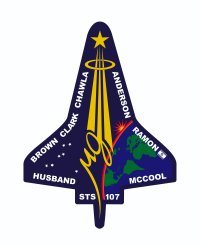 As the space shuttle Columbia lifted off for the
last time on Jan. 16, it was hit by debris from the external fuel
tank as many as three times. Now, new NASA data indicates a
temperature spike immediately following the impacts - a potential
indication of the shuttle's impending doom.
As the space shuttle Columbia lifted off for the
last time on Jan. 16, it was hit by debris from the external fuel
tank as many as three times. Now, new NASA data indicates a
temperature spike immediately following the impacts - a potential
indication of the shuttle's impending doom.
As ANN has reported extensively, chunks of insulating foam broke
away from the huge, orange external fuel tank broke away and
impacted both the leading edge and the underside of the space
plane's left wing. Now, ABC News reports heat sensors indicated a
temperature spike in the exact same area, just 40 seconds after the
debris impact. At that point in the flight, ABC reports, the
temperatures should have been holding steady or even falling.
Two weeks later, Columbia disintegrated upon re-entry. After
initial denials that the foam impact was a factor in the disaster,
NASA and other government investigators are focusing more and more
on what role the falling debris played in Columbia's demise.
CAIB Recommendations
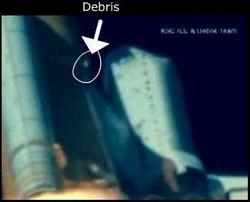 The discovery of that critical sensor information
came as the Columbia Accident Investigation Board made its first
recommendations to NASA on how to avoid a third shuttle
catastrophe.
The discovery of that critical sensor information
came as the Columbia Accident Investigation Board made its first
recommendations to NASA on how to avoid a third shuttle
catastrophe.
Recommendation One: Prior to return to flight,
NASA should develop and implement a comprehensive inspection plan
to determine the structural integrity of all Reinforce
Carbon-Carbon (RCC) system components. This inspection plan should
take advantage of advanced non-destructive inspection
technology.
This recommendation was issued because of the board's finding
that current inspection techniques are not adequate to assess
structural integrity of RCC, supporting structure, and attaching
hardware.
Recommendation Two: Prior to return to flight,
NASA should modify its Memorandum of Agreement with National
Imagery and Mapping Agency (NIMA) to make on-orbit imaging for each
Shuttle flight a standard requirement.
This recommendation was issued because of the board's finding
that the full capabilities of the United States Government to image
the Shuttle on orbit were not utilized.
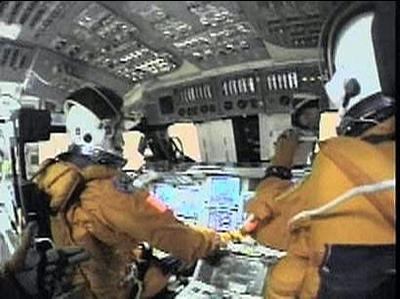
Facts Regarding RCC Components - The board will include the
following facts in its final report:
The Reinforced Carbon-Carbon (RCC) system (including all RCC,
supporting structure and attaching hardware) is an essential
component of the Space Shuttle Orbiter Thermal Protection System
(TPS) and has a Criticality Rating of 1 (loss of crew - loss of
vehicle).
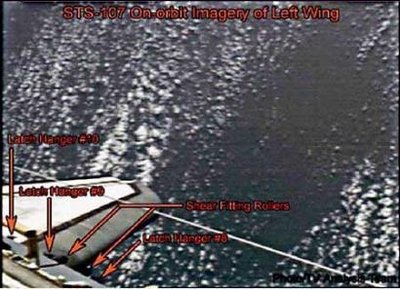
The RCC composite consists of a reinforced carbon-carbon
substrate that carries the structural loads, a tetraethyl
orthosilicate impregnation that reduces inherent substrate
porosity, a silicon carbide treatment that protects the substrate
from oxidation, and a sealant coating that provides additional
oxidation protection. These composite structures are attached to
the shuttle by a metal support system.
During initial manufacturing acceptance, the integrity of
production composites used in the RCC system is checked at various
points in production by physical tap, ultrasonic, radiographic,
eddy current, weight gain, and visual tests. In addition, a flat
plate control panel made in parallel with the production piece is
destructively tested at various points in the production
process.
A projected design mission life has been established for each
RCC component. These projections are based on analysis correlated
to simulated flight load testing, and assume the presence of sound
composite material and metal support structure.
Visual external inspections and tactile checks are the only
specified post flight inspections of RCC composite components. The
planned interval for removing RCC composite components for more
thorough inspection is typically many flights, unless their removal
is dictated by an observed visual surface condition or necessitated
by the requirement to provide access for other operations.
Non-destructive testing of some post-flight RCC components has
shown indications of RCC material defects not previously identified
by visual inspection methods currently employed.
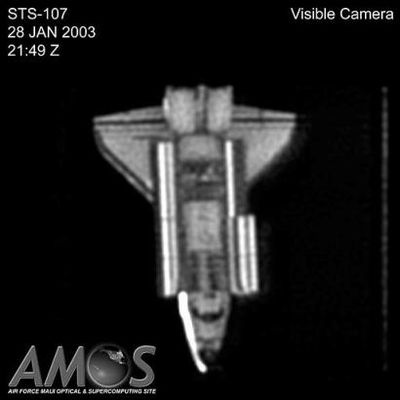
Facts Regarding Shuttle Imaging - The board
will include the following facts in its final report:
The U.S. Government has the capability to image the Shuttle on
orbit.
A Memorandum of Agreement exists between NASA and NIMA regarding
on-orbit imaging of the Shuttle.
During the flight of STS-107, there were no on-orbit images
taken of sufficient resolution to assess the Orbiter's
condition.
The CAIB issued these recommendations and findings in advance of
their appearance in the final report. The board's final report will
be issued later this summer. It will include the probable cause of
the accident, contributing factors, findings and additional
recommendations.
(Source: Columbia Accident Investigation Board)
Dittemore History?
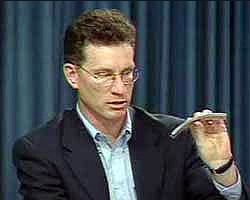 CBS News reports the director of NASA's space
shuttle program, Ron Dittemore, is on his way out. Contractors tell
the network Dittemore will leave the space agency to enter private
business, perhaps working for a firm that supplies technology to
the space program. His departure, already a hot rumor at both KSC
and Houston, will be a loss keenly felt at NASA.
CBS News reports the director of NASA's space
shuttle program, Ron Dittemore, is on his way out. Contractors tell
the network Dittemore will leave the space agency to enter private
business, perhaps working for a firm that supplies technology to
the space program. His departure, already a hot rumor at both KSC
and Houston, will be a loss keenly felt at NASA.
"He did a good job, Ron is a solid manager," said one senior
aerospace manager quoted by CBS. "One of his traits was he was not
unwilling to make hard decisions. He made decisions that weren't
always popular, but they were the right thing to do."
But can he do it? Can Dittemore leave NASA and go straight to
work for an aerospace firm that contracts to the space agency? As
it stands, the answer is "no." Dittemore would need a waiver from
NASA Administrator Sean O'Keefe. Those waivers aren't very easy to
come by and are rarely, if ever, granted.
CBS reports Dittemore joined NASA in 1977 as a propulsion
engineer on the shuttle program. He moved up through the ranks of
middle, then senior, management. In 1995, he became manager of
shuttle integration and chairman of NASA's mission management
organization, overseeing the day-to-day minutia of each shuttle
mission. In 1999, Dittemore replaced Tommy Holloway as shuttle
program manager.
 ANN's Daily Aero-Term (04.24.24): Runway Lead-in Light System
ANN's Daily Aero-Term (04.24.24): Runway Lead-in Light System ANN's Daily Aero-Linx (04.24.24)
ANN's Daily Aero-Linx (04.24.24) Aero-FAQ: Dave Juwel's Aviation Marketing Stories -- ITBOA BNITBOB
Aero-FAQ: Dave Juwel's Aviation Marketing Stories -- ITBOA BNITBOB Classic Aero-TV: Best Seat in The House -- 'Inside' The AeroShell Aerobatic Team
Classic Aero-TV: Best Seat in The House -- 'Inside' The AeroShell Aerobatic Team Airborne Affordable Flyers 04.18.24: CarbonCub UL, Fisher, Affordable Flyer Expo
Airborne Affordable Flyers 04.18.24: CarbonCub UL, Fisher, Affordable Flyer Expo








